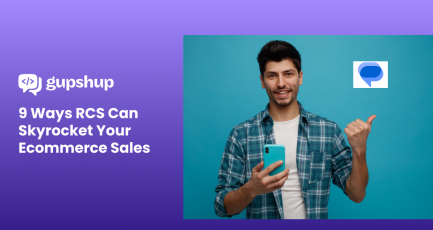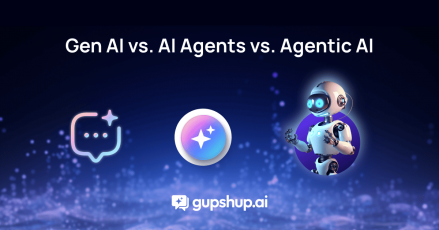How Restaurants Can Effectively Use WhatsApp Chatbots to Boost CX this Festive Season

Introduction
The festive season is about to hit, and your restaurant will be packed to the brim. The phones won’t stop ringing, orders will come in faster than the kitchen can handle, and reservations will pile up with no time to catch a breath. Guests will line up at the door while your staff may struggle to keep up with the chaos. Inquiries about holiday specials can go unanswered, and tables meant for large parties can accidentally be double-booked.
It will be a race against the clock, and no matter how hard your team works, it will always feel like everything’s slipping through the cracks. With the holiday rush pushing your staff to the edge, maintaining the level of service customers expect seems impossible.
But what if there was a way to manage it all seamlessly, easing the burden on your team and keeping your operations running smoothly? That’s where the power of WhatsApp chatbot comes in, ready to take on the heavy lifting and keep your restaurant on track during the busiest times of the year.
If you haven’t considered it yet, the future of chatbots is something every forward-thinking restaurant should be embracing. Imagine a solution that allows your customers to make reservations, place orders, or ask questions 24/7 without tying up your staff’s time. That’s exactly what you get with AI chatbots.
Businesses can experience up to a 45% increase in conversions through live chat after implementing chatbots. And it’s not just a quick spike in activity—customers are more likely to return to your website because of the smooth experience.
At the end of the day, your restaurant’s success does not just depend on great food—it’s about delivering a seamless customer experience from start to finish. And with an AI chatbot working behind the scenes, you’ll be able to do that effortlessly, even during your busiest periods.
So, if you’re looking to streamline your operations, boost customer satisfaction, and cut costs, it might be time to take the leap. The future of chatbots is here, and it’s time for your restaurant to reap the rewards.

Why Your Restaurant Needs A WhatsApp Chatbot This Festive Season

Traditional customer service channels often get jam-packed during the festive season, which leads to longer wait times and a less-than-ideal experience for your guests. AI chatbots can help reduce those frustrating wait times. Whether customers are asking about reservations, menu items, or holiday specials, the chatbot can handle it all—quickly and efficiently.
| In fact, chatbots can reduce wait times by up to 80% during busy periods, which can significantly improve customer satisfaction. |
Here are some reasons why your restaurant should invest in a chatbot –
Boosting your restaurant’s operational efficiency
While chatbots are great for improving customer experience, they’re also a huge help when it comes to operational efficiency. By automating routine tasks—like taking orders, managing reservations, and answering FAQs—chatbots free up your staff to focus on other important tasks – like guests who are dining in or making sure holiday events run smoothly.
Plus, these AI chatbots can integrate with your restaurant’s POS system, so orders are automatically logged and payments are processed seamlessly. This reduces the risk of human error and ensures that everything flows smoothly from the time an order is placed to when it reaches the kitchen.
For you, this means fewer mistakes, happier customers, and a more efficient operation overall.
The numbers speak for themselves
The impact of dining with AI chatbots is hard to ignore.
- Restaurants that use chatbots see a 15% improvement in conversion rates during peak periods and notice customer engagement increase threefold.
- They also help cut operational costs by up to 30%, which can be a big deal when you’re managing the holiday rush.
WhatsApp Chatbots: Transforming Your Restaurant Experience

Let’s dive into how chatbots can transform your restaurant experience, especially during high-traffic times.
1. Order and delivery management
AI chatbots automate the order-taking process across various platforms, whether it’s your website, social media, or messaging apps like WhatsApp. They ensure that orders are accurate by confirming details instantly with the customer, cutting down on human errors—something that’s especially helpful when things get hectic.
For example, when a customer places an order through a WhatsApp chatbot, it processes the request, confirms the order, and sends it directly to the kitchen.
2. Reservation handling
Managing reservations via call can be time-consuming, but with a chatbot, this process becomes much easier. AI chatbots allow your customers to book tables anytime, without having to wait for someone to pick up the phone. Customers simply input their preferred date, time, and party size, and the chatbot confirms the booking instantly, syncing it with your reservation system.

3. Personalized recommendations
One of the best parts about using an AI chatbot is its ability to offer personalized recommendations. Chatbots can use customer data, such as past orders and preferences, to suggest dishes that match their tastes. For example, if someone often orders a certain type of dish, the chatbot might recommend complementary items, like drinks or desserts, based on those preferences.
This personalized touch doesn’t just improve the dining experience—it also helps boost sales. Some restaurants even saw a 12% increase in the average order value. Dining with AI chatbots means Add a Coke.
your guests get the personal attention they appreciate while you benefit from higher upsell opportunities.
4. Click-to-WhatsApp (CTWA) campaigns
For restaurants looking to connect with customers more effectively, Click-to-WhatsApp (CTWA) campaigns are a powerful tool. These paid ads, typically run on platforms like Facebook or Instagram, allow users to click on an ad and immediately start chatting with your restaurant through WhatsApp chatbots.
Targeting customers directly where they spend the most time—on social media—improves conversion rates. CTWA campaigns allow you to reach more customers and provide them with a seamless experience, boosting both short-term orders and long-term loyalty.

5. Omnichannel presence
By offering your chatbot on websites, mobile apps, social media, and especially messaging platforms like WhatsApp, you provide a consistent experience no matter where the customer interacts with you. Whether they’re browsing your menu on a website or placing an order through a WhatsApp chatbot, they’ll receive the same level of service across the board.
This omnichannel approach allows customers to easily start a conversation on one platform (like a mobile app) and continue it on another (like your website) without losing any context.
It not only boosts convenience but also builds trust. Some of the biggest F&B companies have seen major benefits by integrating chatbots across different touchpoints. For restaurants, this can ensure smooth, seamless dining with AI chatbots, making sure customers feel supported no matter how they engage with your business.

Ready to Build a Chatbot for Your Diner? Here’s How

Here’s how you can get started on building a chatbot that’s tailored to your restaurant’s unique needs.
1. Define the chatbot’s purpose
The first step is to figure out exactly what you want your AI chatbot to do. Do you need it to manage table reservations, take orders, answer customer questions about your menu, or maybe collect feedback? Defining these goals will help shape the chatbot and ensure it delivers value to both your customers and your restaurant.
2. Map out the conversation flow
Next, think through how the chatbot will interact with your customers. What should the conversation flow look like? Whether a customer is exploring your menu, placing an order, or booking a table, each interaction should follow a logical path. Mapping out flows like:
Greeting → Menu Browsing → Order Confirmation, or
Greeting → Reservation Booking → Confirmation
This will make sure the chatbot guides customers smoothly through each step, mimicking natural human-like conversations.
3. Craft a warm introduction
First impressions matter, even with chatbots! Start with a friendly, welcoming, and personalized message that tells customers what the WhatsApp chatbot can do. Something like:
“Hi John, welcome to [Restaurant Name]! I’m here to help with orders, reservations, and today’s specials. What can I assist you with today?”
This sets the right tone and gives customers a clear idea of what they can expect.
4. Use simple, user-friendly design
Make it easy for customers to navigate by using intuitive design elements like buttons, quick replies, and carousels. For instance, buttons can help customers pick a reservation time or quickly choose from menu options. This simple approach ensures customers won’t get confused or stuck during their interaction.
5. Gather feedback
Make sure to include a way for customers to leave feedback about their experience. A simple question like “How was your experience today?” after each interaction, or even a post-meal follow-up for a quick review, can provide you with valuable insights. This feedback can help you fine-tune your AI chatbot over time.
6. Test and improve
Before launching, it’s crucial to test your chatbot thoroughly. Simulate different scenarios—whether it’s placing an order or making a reservation—to see how well it performs under various conditions. Keep refining the chatbot based on user feedback and real-world experiences, especially during busy times like weekends or holidays.
The Future of Chatbots in the Restaurant Industry
As restaurants look to the future, chatbots are set to integrate more advanced technologies like voice-enabled assistants and AI-driven data analytics. Beyond automating tasks like order-taking and reservations, they offer real-time, 24/7 service, ensuring customers can engage at any time without delays. By reducing wait times and improving accuracy, chatbots streamline operations and reduce the burden on staff. This efficiency allows the team to focus on delivering better in-person service.
Additionally, AI chatbots enhance the dining experience by offering personalized recommendations based on customer data, increasing upsell opportunities and boosting order values. Restaurants using chatbots have reported higher conversion rates and improved customer satisfaction, making them invaluable during high-traffic periods.
To get started, platforms like Gupshup offer tools to create tailored chatbots that meet your restaurant’s specific needs. Explore how these solutions can transform your operations this festive season.
Frequently Asked Questions (FAQs)
1. Can restaurants use a chatbot?
Yes, restaurants can use chatbots to automate tasks such as order-taking, reservations, and answering FAQs. This helps streamline operations, reduce wait times, and enhance customer experience, especially during peak times like the festive season.
2. What is CX in chatbot?
CX (Customer Experience) in chatbots refers to the overall interaction customers have with a business’s chatbot. It includes ease of use, personalization, efficiency, and satisfaction throughout the customer journey, from inquiry to order completion.
3. How can a WhatsApp chatbot improve customer satisfaction?
WhatsApp chatbots improve customer satisfaction by providing instant responses, reducing wait times, offering personalized recommendations, and ensuring 24/7 service availability. They streamline communication and minimize human errors, creating a more efficient and seamless customer experience.
Here are some insightful resources on WhatsApp chatbots and their applications:
- WhatsApp Chatbot Messaging: 5 Reasons to Start Right Now (eBook)
- How Gupshup Helped EdTech Doubtnut with WhatsApp Chatbot (Case Study)
- No-Code Guide to Creating and Deploying a WhatsApp Chatbot
- The Ultimate WhatsApp Chatbot Distribution Strategy (White Paper)
- WhatsApp Chatbots: How They’re Making Your Festive Campaigns Conversational




